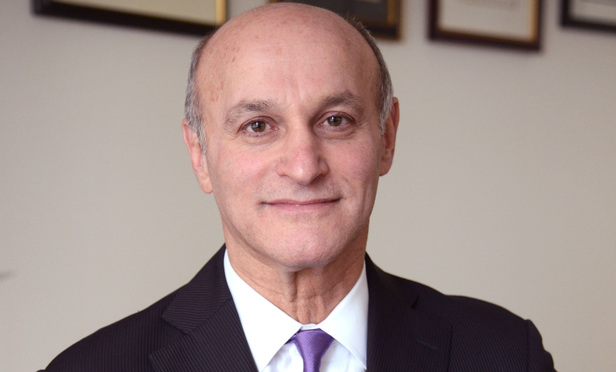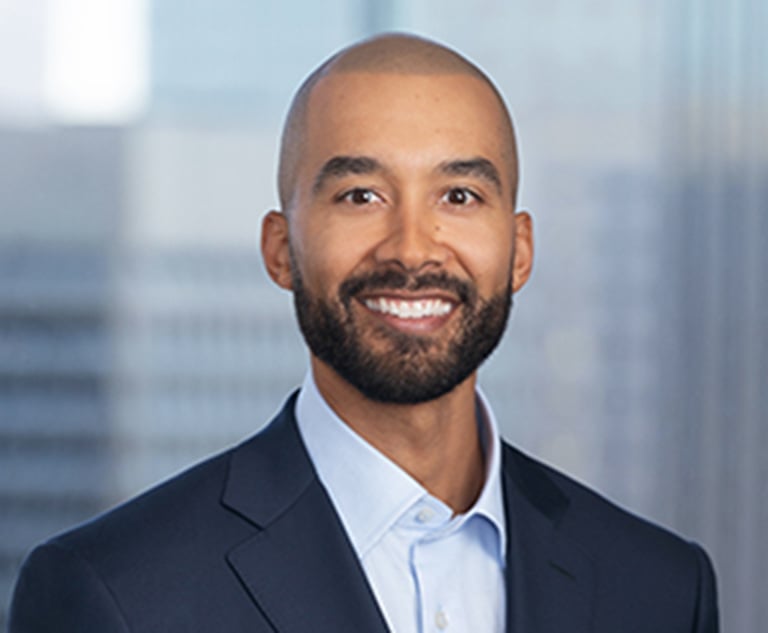NY Sees Progress on Court Backlog as 'Excellence Initiative' Enters Fourth Year
The evergreen issue of court backlog in New York state's judiciary is becoming less problematic as Chief Judge Janet DiFiore's Excellence Initiative enters its fourth year, during which the Office of Court Administration plans to build on the progress already achieved since 2016.
March 11, 2019 at 05:20 PM
7 minute read
 Chief Administrative Judge Lawrence Marks.
Chief Administrative Judge Lawrence Marks.
The evergreen issue of court backlog in New York state's judiciary is becoming less problematic as Chief Judge Janet DiFiore's Excellence Initiative enters its fourth year, during which the Office of Court Administration plans to build on the progress already achieved since 2016.
Chief Administrative Judge Lawrence Marks said in an interview Monday that the program has had a positive impact statewide, where the decrease in backlog has ranged anywhere from 20 percent in some cases to more than 80 percent in others.
“The program has been a success in all parts of the state and every level of court across the state,” Marks said. “The numbers bear that out.”
The numbers vary depending on where you look, but backlog has been reduced by at least 20 percent in New York City and the rest of the state between January 2016 and February 2019. The progress has been much greater in some areas, and overall it's in stark contrast to when delays were ever-increasing before DiFiore took office.
The Ninth Judicial District in the lower Hudson Valley and New York City suburbs, for example, has seen a 91 percent decrease in the number of pending felony cases in the past three years.
The benchmark for measuring that type of progress is based on a set of standards used by OCA based on the type of litigation and, in the case of crime, level of charge. The standards and goals for felony cases, for example, is six months.
The percent reduction in backlog, regardless of the type of litigation, has been larger outside New York City. Felony backlog has been reduced by 67 percent over standards and goals, and misdemeanor backlog has gone down by 53 percent outside the five boroughs. Pending civil cases in state Supreme Court have gone down 51 percent in those areas and only 4 percent of cases in family court are over standards and goals.
Some areas of the state outside New York City have done better than others in reducing backlog, but progress has been made in every region. Felony backlog in the Fourth Judicial District, which encompasses the northern part of the Capital Region and the North Country, has gone down 67 percent. Pending misdemeanors in the Eighth Judicial District, in Western New York, have decreased by 75 percent.
Backlog reduction in New York City has been lower, but there are areas that have made massive progress since the Excellence Initiative started. The number of misdemeanor cases one year or older have decreased by 84 percent in the Bronx, for example.
Citywide, felony backlog has gone down by 24 percent over standards and goals and the number of pending misdemeanors has decreased by 40 percent. More specifically, there's been a 78 percent reduction citywide in the number of misdemeanor cases one year or older.
“Our goal is that there should be no cases one year or older, but we have dramatically reduced the number of those cases by 78 percent over the last three years,” Marks said.
The state Supreme Court in New York City has seen a 24 percent reduction in pending cases over standards and goals since January 2016, with a 49 percent reduction in backlogged mortgage foreclosure cases alone. State Supreme Court backlog in Queens has, notably, been reduced by 39 percent over standards and goals.
The number of family court cases in New York City over standards and goals, which is six months, has actually increased from a few years ago, Marks said. Part of that is due to a surge in abuse and neglect filings, Marks said, but the court system is also feeling the ripple effects of Raise the Age. The program aims to send most cases involving minors out of criminal court and into family court.
“We've had to adjust statewide, but the adjustment in New York City is a bigger adjustment than it's been in the counties outside New York City,” Marks said.
The first phase of the program was implemented last October, when the state stopped treating 16-year-olds as adults in state courts, instead sending most of their cases to family court or a new youth part of the criminal court. The second phase will start this October, when the same treatment is given to 17-year-olds.
Marks told lawmakers during a budget hearing in January that, as of now, the court system isn't requesting that the Legislature approve more family court judges in response to the program. That could change down the road, but Marks said they'll cross that bridge when they come to it.
“We're going to have to reassess when the full brunt of the law kicks in next October,” Marks said. “It's true we haven't asked the Legislature for additional family court judgeships. We haven't felt the need to do that yet, but we'll see what happens when the full law takes effect.”
Reversing the tide on court backlog in New York hasn't been an easy task, and much of it has been accomplished through the use of data and local management by administrative judges statewide, Marks said.
“We've really made our administrative judges accountable and responsible for working with their judges to resolve older cases,” Marks said. “We've been keeping and collecting extensive data on our caseloads by individual court, by case type, by age of case, by individual judge, and even by attorney. … That's been critical to analyzing where the backlogs are, identifying where they are, and helping to address the backlogs where they exist.”
The focus of the Excellence Initiative, Marks said, has always been to resolve the oldest cases in state courts first, and to simultaneously work to prevent new cases from becoming backlogged. OCA started the Special Term Additional Resources Trial Team, or START, in the Bronx in January to address 100 of the borough's oldest felony cases involving jailed defendants. The four-judge team, led by Judge Barry Warhit, the supervising judge of the criminal courts for the Ninth Judicial District, resolved all 100 of those cases by the end of February.
Warhit will now be leading a similar initiative starting in April in Manhattan, which also has some of the most significant backlog in the state. Marks said aside from implementing START in Manhattan, OCA plans to place new focus on reducing felony backlogs in New York City courts, where progress has lagged behind other areas.
“The part of the state and type of courts where we've made good progress but we need to make more and we're redoubling our focus on those courts are the felony courts in New York City,” Marks said.
READ MORE:
DiFiore Renews Call for Lawmakers to Restructure NY Court System
OCA Mulls Rule Requiring Judicial Warrants for ICE Arrests in NY Courts
Judiciary Requests 2 Percent Spending Increase From Cuomo, NY Lawmakers
NOT FOR REPRINT
© 2025 ALM Global, LLC, All Rights Reserved. Request academic re-use from www.copyright.com. All other uses, submit a request to [email protected]. For more information visit Asset & Logo Licensing.
You Might Like
View All


Prosecutors Ask Judge to Question Charlie Javice Lawyer Over Alleged Conflict
Trending Stories
- 1Perkins Coie Lures Former Longtime Wilson Sonsini Tech Transactions Partner
- 2‘The Decision Will Help Others’: NJ Supreme Court Reverses Appellate Div. in OPRA Claim Over Body-Worn Camera Footage
- 3MoFo Associate Sees a Familiar Face During Her First Appellate Argument: Justice Breyer
- 4Antitrust in Trump 2.0: Expect Gap Filling from State Attorneys General
- 5People in the News—Jan. 22, 2025—Knox McLaughlin, Saxton & Stump
Who Got The Work
J. Brugh Lower of Gibbons has entered an appearance for industrial equipment supplier Devco Corporation in a pending trademark infringement lawsuit. The suit, accusing the defendant of selling knock-off Graco products, was filed Dec. 18 in New Jersey District Court by Rivkin Radler on behalf of Graco Inc. and Graco Minnesota. The case, assigned to U.S. District Judge Zahid N. Quraishi, is 3:24-cv-11294, Graco Inc. et al v. Devco Corporation.
Who Got The Work
Rebecca Maller-Stein and Kent A. Yalowitz of Arnold & Porter Kaye Scholer have entered their appearances for Hanaco Venture Capital and its executives, Lior Prosor and David Frankel, in a pending securities lawsuit. The action, filed on Dec. 24 in New York Southern District Court by Zell, Aron & Co. on behalf of Goldeneye Advisors, accuses the defendants of negligently and fraudulently managing the plaintiff's $1 million investment. The case, assigned to U.S. District Judge Vernon S. Broderick, is 1:24-cv-09918, Goldeneye Advisors, LLC v. Hanaco Venture Capital, Ltd. et al.
Who Got The Work
Attorneys from A&O Shearman has stepped in as defense counsel for Toronto-Dominion Bank and other defendants in a pending securities class action. The suit, filed Dec. 11 in New York Southern District Court by Bleichmar Fonti & Auld, accuses the defendants of concealing the bank's 'pervasive' deficiencies in regards to its compliance with the Bank Secrecy Act and the quality of its anti-money laundering controls. The case, assigned to U.S. District Judge Arun Subramanian, is 1:24-cv-09445, Gonzalez v. The Toronto-Dominion Bank et al.
Who Got The Work
Crown Castle International, a Pennsylvania company providing shared communications infrastructure, has turned to Luke D. Wolf of Gordon Rees Scully Mansukhani to fend off a pending breach-of-contract lawsuit. The court action, filed Nov. 25 in Michigan Eastern District Court by Hooper Hathaway PC on behalf of The Town Residences LLC, accuses Crown Castle of failing to transfer approximately $30,000 in utility payments from T-Mobile in breach of a roof-top lease and assignment agreement. The case, assigned to U.S. District Judge Susan K. Declercq, is 2:24-cv-13131, The Town Residences LLC v. T-Mobile US, Inc. et al.
Who Got The Work
Wilfred P. Coronato and Daniel M. Schwartz of McCarter & English have stepped in as defense counsel to Electrolux Home Products Inc. in a pending product liability lawsuit. The court action, filed Nov. 26 in New York Eastern District Court by Poulos Lopiccolo PC and Nagel Rice LLP on behalf of David Stern, alleges that the defendant's refrigerators’ drawers and shelving repeatedly break and fall apart within months after purchase. The case, assigned to U.S. District Judge Joan M. Azrack, is 2:24-cv-08204, Stern v. Electrolux Home Products, Inc.
Featured Firms
Law Offices of Gary Martin Hays & Associates, P.C.
(470) 294-1674
Law Offices of Mark E. Salomone
(857) 444-6468
Smith & Hassler
(713) 739-1250







